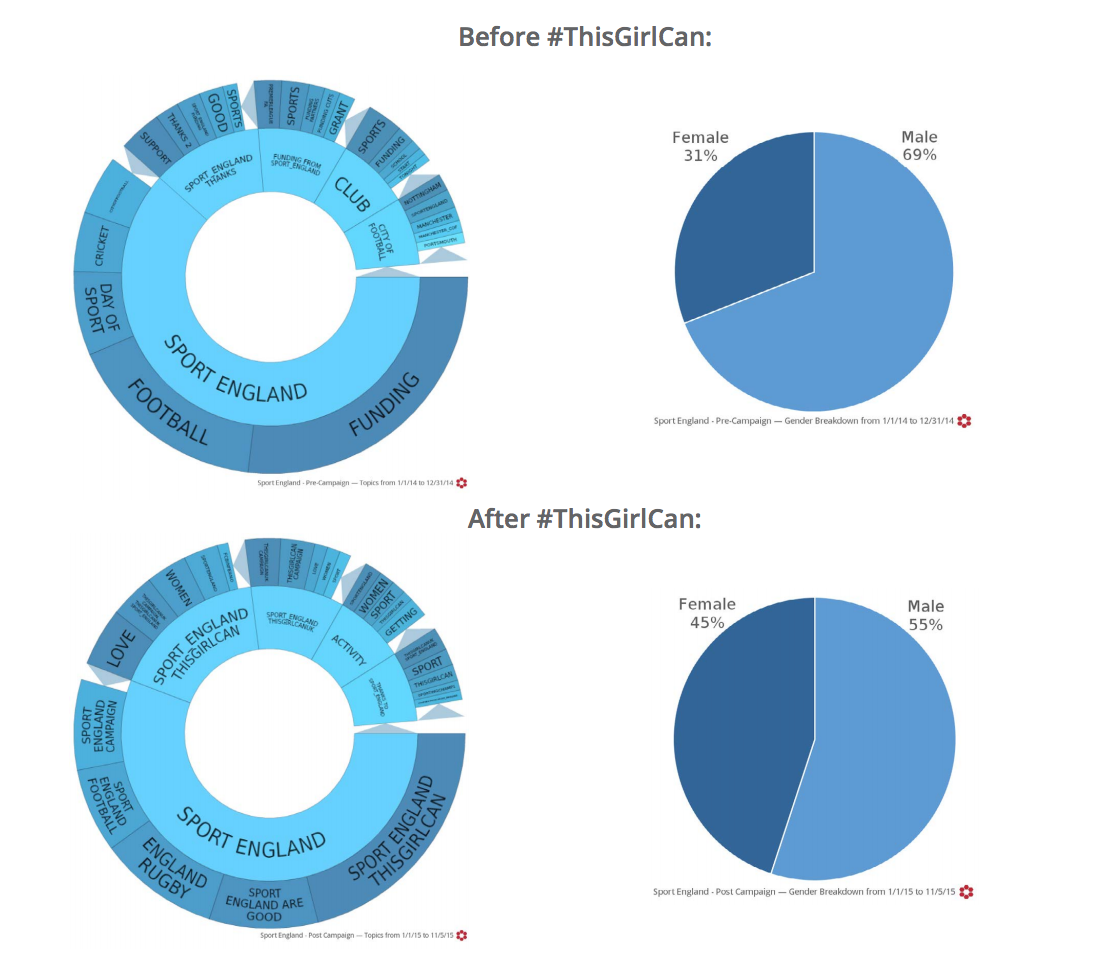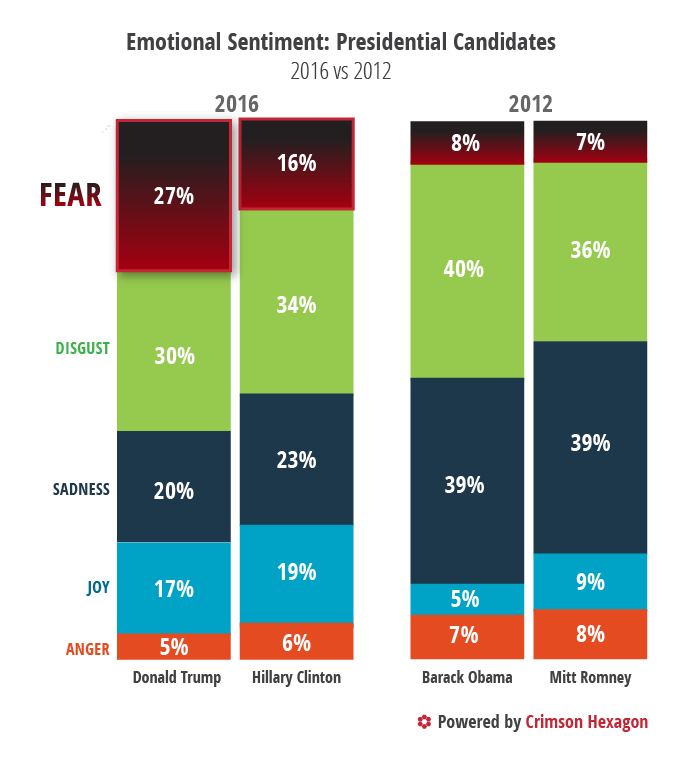Perspective
How social data informs business decisions and drives social change

Social data, more than any other source of information, reveals what people care about most. For the last decade, social media analytics firm Crimson Hexagon (@crimsonhexagon) has been taking the pulse of social networks across the planet and using that data to produce reams of insightful and original research.
That's why the world's top brands – including Amazon, Walmart, Starbucks, NBC Universal, and Netflix – rely on Crimson's social media analytics platform to gain insight into their audiences, build effective social campaigns, and drive key business decisions.
But social media is more than just business and brands; at its core it's all about people. A huge advantage of applying artificial intelligence to 1 trillion social media posts is the ability to identify broader global movements. One of the many trends Crimson has identified is the growing influence of women as an economic and political force.
By analysing social data, Crimson has measured everything from the appeal of Suicide Squad's Harley Quinn and Mattel's new, more diverse line of Barbies to how Adele fans truly feel about her hit single "Hello."
But social analytics also helped women in the UK to overcome body image problems and improve their health, helped a leading maker of musical instruments to appeal to more female musicians, and gauged the impact of protests like the US Women's March on the political landscape.
Here are three of the ways Crimson has tracked the growing power of women's voices.
Let's get physical
When Sport England (@Sport_England) wanted to know why women in Great Britain don't exercise more, it turned to Crimson’s social analytics platform for answers. The UK sports agency already knew that British women in the prime of their life are significantly less active than their male peers; the question was, how could it use social media to increase women’s participation in sports?
By analysing millions of Tweets, Crimson identified the key reason behind the disparity: fear of judgement. Women were worried about being perceived as unfeminine or too competitive, leading them to exercise less as a result. Furthermore, mothers felt guilty about taking time away from their families to exercise.
With the help of Crimson’s research, Sport England launched a social media and traditional campaign using the hashtag #ThisGirlCan to help women reshape their attitudes toward sports and physical activity, and to try and tackle the gender gap in sports.
Some 7.5 million people witnessed the January 2015 launch of #ThisGirlCan, which included TV ads, a website, and a dedicated Twitter handle (@ThisGirlCanUK) that Tweets gentle encouragement and advice to its followers.

The impact was dramatic and immediate: One out of every three women who viewed the campaign said they became more active as a result. After #ThisGirlCan, the number of UK women talking about Sport England on social media increased dramatically.
By April 2015, female conversations about playing football exceeded those about watching it by more than five to one. During the same month, conversations about training spiked, with three times as many posts as before the campaign. While a number of factors may have influenced this growth, #ThisGirlCan clearly had a significant impact.
Seeking guitar heroines
Besides changing consumer behaviour, social media can help businesses identify and appeal to more diverse markets. Take music, for example. Nearly every music-loving boy dreams of becoming a guitar hero, but that’s not always the case for girls. Fender Musical Instruments Corp. (@Fender), one of the world’s leading manufacturers of guitars, wanted to change that, so it asked Crimson for help analysing its social channels and devising a strategy to boost Fender's appeal to a female audience.
"One of our big targets as a brand right now is to get a little more gender balanced," says BJ Carretta, former vice president of digital brand marketing, media, communications, and partnerships for Fender. "Our channels tend to skew very male. We're using these tools to understand where female guitar players are, what are they talking about, what are their interests, what are their barriers to entry to coming into our community."
One effective tactic was promoting women who were already sharing their guitar prowess online and creating original content around them. Another was creating Girl Rock Nation (@girlrocknation), a multi-age community of female guitarists, and offering curated selections of instruments geared towards a female audience.
The ability to monitor the social conversation happening on Twitter through Crimson Hexagon enabled Fender to unlock a new market segment it wasn’t previously as focused on. The data helped the company identify this new audience based on their interests, track the conversation, and hone in on what mattered most to them.
Using Crimson’s platform, Fender could run queries and glean what its female audience wanted to see more of, and form strong opinions on how to further enhance their engagement.
Marching for joy
Finally, there’s the political realm. This is where sentiment analysis plays a key role – knowing how people feel can be an accurate predictor of how they'll act, whether they're shopping for guitars or voting for a president.
For example, when Crimson Hexagon performed sentiment analysis prior to the 2016 US presidential election, fear and disgust dominated the social conversation, accounting for nearly 60% of sentiments expressed.

After the Women's March last January, however, that appeared to change. The sentiment of joy experienced a surge. While some of those joyous Tweets likely correlated to the inauguration, Crimson’s sentiment analysis showed that a significant percentage related directly to the march itself.
Crimson also captured the world's reaction. One out of every 10 social posts in New Zealand was about the march, one out of every four in Norway, and one out of three in Brazil. Even Antarctica weighed in.
This event took place on social media as much as in the streets, generating more than 1.5 times as many Tweets and Retweets as the US presidential inauguration the day before. Marchers shared hundreds of thousands of photos, videos, and impressions of the global event, but the most widely shared post belonged to actor Nick Offerman.
“Even though the Women’s March took place in Washington DC, you could say that it really took flight on social media. In fact, social media in general, and Twitter in particular, helped the organisers of the Women’s March amplify their core message: Women’s rights is not a niche issue that only affects a subset of the population; it is a powerful cause that spans genders, countries, and races.
And, in the months since the Women’s March, we’ve seen this sentiment spread even further throughout social with the #MeToo hashtag on Twitter. Together, #MeToo and the Women’s March make it clear that social media is not simply a place where people can participate in social activism, but an essential vehicle for broadening the reach and impact of these movements.”
– Stephanie Newby, CEO, Crimson Hexagon
When you need to find out what the world is thinking, you turn to social media. When you want to test your hypotheses and understand the root causes of data and trends, it can be an invaluable tool. And when you want to make sense of that data and separate the signal from the noise, companies like Crimson Hexagon can provide the answers.